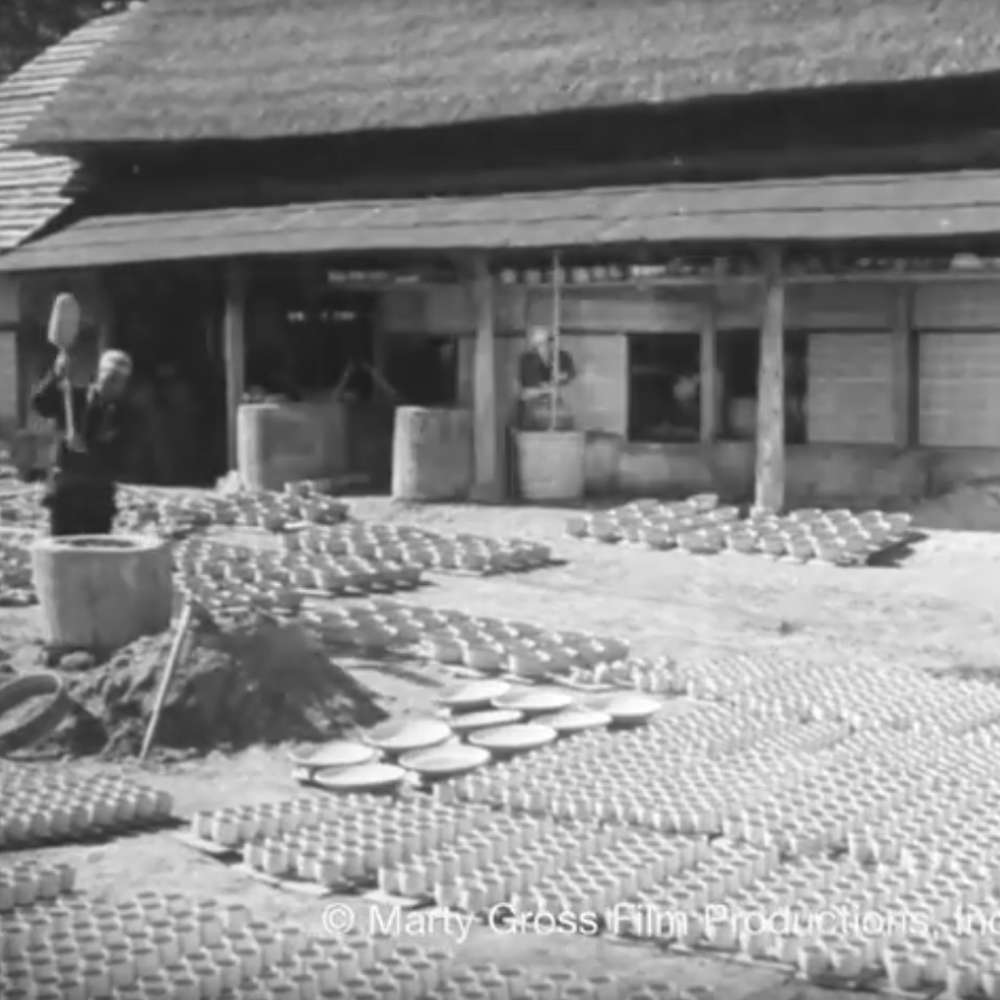Way back when CFile was just a baby, we ran an article about an ambitious project by filmmaker Marty Gross. Gross has been producing films about Japanese art since 1975. Two years ago Gross was attempting to raise a quarter of a million dollars to restore five hours of unedited film shot by British craftsman Bernard Leach who was documenting the Mingei folk craft art movement in Japan. From the studio:
The Mingei Project is particularly important because the films capture a pivotal time in history following Leach and such seminal Japanese figures as philosopher Soetsu Yanagi and potter Shoji Hamada, as they developed ideas that changed the direction of hand craftsmanship.
Seven films comprise the set. They begin with Trip to Japan, documentary footage Leach shot in 1934. The films span decades to include a 1971 film The Art of the Potter by David Outerbridge and Sidney Reichman. Of particular note is a 1937 film, Mashiko Village Pottery, Japan 1937, which follows pottery manufacturing in the workshop of Totaro Sakuma.
We’re happy to say that the footage has never looked better. In our post two years ago we ran images showing the unedited film running next to the restored image and the contrast couldn’t have been more pronounced. The studio gave us a present recently by releasing a full seventeen minutes of pristine-quality black and white footage from the workshop. A window into history, it’s crisp, gorgeous and the casual documentary nature of many of the shots makes everything feel immediate, as though the intervening 80 years haven’t happened at all. Fantastic stuff. Please enjoy it.
Do you love or loathe this example of (not quite) contemporary ceramic art? Let us know in the comments.

Such a rare and superb example of Mashiko potters in a historic setting.
THANK YOU!
It is a joy to view your fine retrospective on Shoji Hamada. I am pleased that it showed so many of the activities he performed, and the equipment he used, in creating his masterpieces. I was lucky to visit his workshop in Mashiko, just after the war. My most vivid memory was recaptured in your film, namely, that every aspect of folk-craft pottery required back-breaking and mind-numbing repetative labor that I could not imagine myself ever being able to master, then to endure doing it on, and on, and on, and on. . . . . . .
Thank you for sharing your memory with us all.
Thank you for this inspiring footage. So much began and blossomed from Leach and Hamada, the Mashiko tradition, their way,their philosophy and their generosity.
Thank you for sharing, it is a treasure!
Thank you for sharing! Great visual appreciation for the cultural legitimacy of clay in Japan just before and after World War I I. Profound work with true purpose in mind is guided by honest community labor.
Very interesting films from the past! We just visited Mashijko and the Museum house of Hamada. As a hobbyist potter from Holland its all so fascinating. I do some salt glazing but would love to know some of the recipes of the glazes they used. Like the Persimmon red glaze and the oilspot ironglaze. All so beautifull!
But also I realise it was hard work in those days when you couldn’t just go to a shop to buy your ready made clay. So lots of admiring for these people!
The persimmon Iron is very hard to replicate even. with the right recipe. jrhunter@mac.com
Thank you! I visited Hamada’s house in the early 1980s with a friend from Mashiko. I didn’t know the importance of what I was seeing at the time. I was lucky enough to be there for the pottery festival.
Looking at the film, I loved watching the glazing techniques (especially the deliberate sprinkling of the glaze) and Hamada’s skillful turning of the footring. And I was struck by the beautiful work clothes of the pottery workers
It is fascinating to see how pottery was made in different times by different cultures. Thank you.
Yegana
http://www.silkyshapes.com.au
It was great to see how it was done in another culture. Labor intensive. I found the copyright intrusive and ill-placed.
Thank you for sharing, this is a very interesting journey into history and makes you appreciate the work of these very talented artists.
Wonderful to see Hamada throwing, turning and decorating pots. His decoration is so loosely casual – masterly!! His comments in English on coming back to St. Ives with Leach are very enlightening.
Wonderful to see him work. some of my friends had met him so i have just heard stories.
Beautifully simple the way he worked.
Wit was wonderful so see the traditional methods and wonderful skills demonstrated in these films. Thank you
Simply wonderful to see all of these films!
thank you so much for posting this video and the time take to restore the footage…… a privilege to see it!
Fantastic! I loved this. I especially love watching the woman decorating the teapots! Thank you so much. Please post more.
I was just planning to take the original VHS in to have it converted to a DVD so I can continue to show it to my classes. It’s a wonderfully complete picture of how pots were made before the era of pre packaged clays and electric kilns. Students are always astonished by it. It was so carefully crafted by a potter to show every step. A great film.
The video will not play.
Really great to see. The spinning of the wheel is a nice touch.
It is especially gratifying to see how the studio workers handled glazing and loading the kiln.
From an historical perspective, this insight into the craft and practices of the shop is enlightening and humanizing.
love watching them throw off the hump, not familiar with wheels you power with a stick from above.